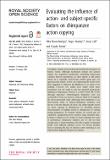Files in this item
Evaluating the influence of action- and subject-specific factors on chimpanzee action copying
Item metadata
| dc.contributor.author | Motes-Rodrigo, Alba | |
| dc.contributor.author | Mundry, Roger | |
| dc.contributor.author | Call, Josep | |
| dc.contributor.author | Tennie, Claudio | |
| dc.date.accessioned | 2021-02-10T10:30:24Z | |
| dc.date.available | 2021-02-10T10:30:24Z | |
| dc.date.issued | 2021-02-10 | |
| dc.identifier | 272432990 | |
| dc.identifier | 56a25196-8105-4473-a1ab-a6c4ece08c3f | |
| dc.identifier | 85103006624 | |
| dc.identifier | 000672607000001 | |
| dc.identifier.citation | Motes-Rodrigo , A , Mundry , R , Call , J & Tennie , C 2021 , ' Evaluating the influence of action- and subject-specific factors on chimpanzee action copying ' , Royal Society Open Science , vol. 8 , no. 2 , 200228 . https://doi.org/10.1098/rsos.200228 | en |
| dc.identifier.issn | 2054-5703 | |
| dc.identifier.other | ORCID: /0000-0002-8597-8336/work/88731204 | |
| dc.identifier.uri | https://hdl.handle.net/10023/21400 | |
| dc.description | This work was supported by the Excellence Initiative of the University of Tübingen. | en |
| dc.description.abstract | The ability to imitate has been deemed crucial for the emergence of human culture. Although non-human animals also possess culture, the acquisition mechanisms underlying behavioural variation between populations in other species is still under debate. It is especially controversial whether great apes can spontaneously imitate. Action- and subject-specific factors have been suggested to influence the likelihood of an action to be imitated. However, few studies have jointly tested these hypotheses. Just one study to date has reported spontaneous imitation in chimpanzees (Persson et al. 2017 Primates 59 , 19–29), although important methodological limitations were not accounted for. Here, we present a study in which we (i) replicate the above-mentioned study addressing their limitations in an observational study of human–chimpanzee imitation; and (ii) aim to test the influence of action- and subject-specific factors on action copying in chimpanzees by providing human demonstrations of multiple actions to chimpanzees of varying rearing background. To properly address our second aim, we conducted a preparatory power analysis using simulated data. Contrary to Persson et al.'s study, we found extremely low rates of spontaneous chimpanzee imitation and we did not find enough cases of action matching to be able to apply our planned model with sufficient statistical power. We discuss possible factors explaining the lack of observed action matching in our experiments compared with previous studies. | |
| dc.format.extent | 20 | |
| dc.format.extent | 795672 | |
| dc.language.iso | eng | |
| dc.relation.ispartof | Royal Society Open Science | en |
| dc.subject | Rearing background | en |
| dc.subject | Anchored actions | en |
| dc.subject | Action copying | en |
| dc.subject | Environmental effects | en |
| dc.subject | Chimpanzees | en |
| dc.subject | Novelty | en |
| dc.subject | BF Psychology | en |
| dc.subject | DAS | en |
| dc.subject.lcc | BF | en |
| dc.title | Evaluating the influence of action- and subject-specific factors on chimpanzee action copying | en |
| dc.type | Journal article | en |
| dc.contributor.institution | University of St Andrews. Centre for Social Learning & Cognitive Evolution | en |
| dc.contributor.institution | University of St Andrews. School of Psychology and Neuroscience | en |
| dc.identifier.doi | https://doi.org/10.1098/rsos.200228 | |
| dc.description.status | Peer reviewed | en |
This item appears in the following Collection(s)
Items in the St Andrews Research Repository are protected by copyright, with all rights reserved, unless otherwise indicated.

